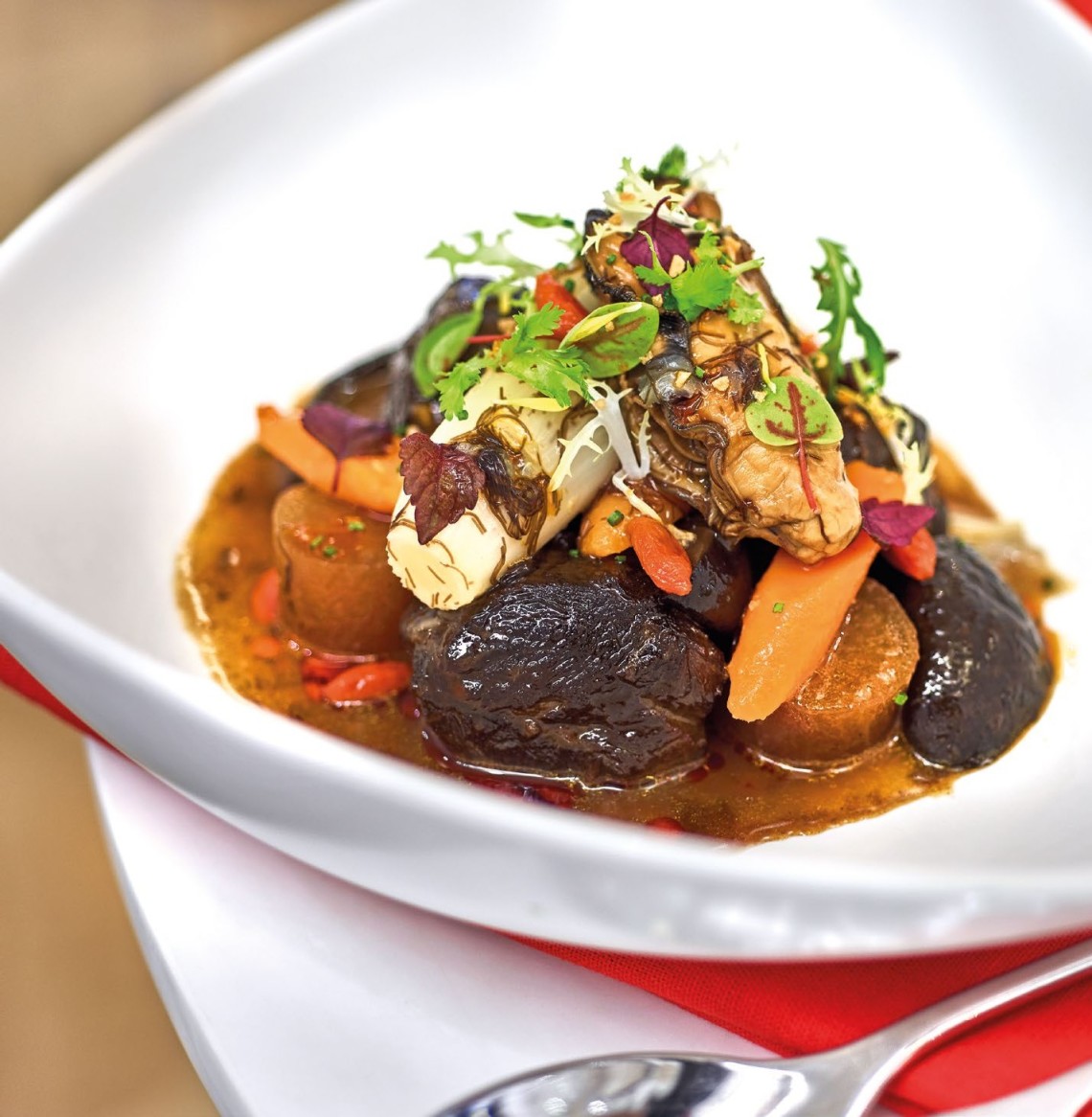We asked chefs to share recipes for their favourite festive dishes and, of course, they had to put their own signature twists to them.


We asked chefs to share recipes for their favourite festive dishes and, of course, they had to put their own signature twists to them. From hearty braises to a delightful icy treat, these are sure-win crowd pleasers.
"Blue Pea Flower Tang Yuan Kakigori, see page 97."

Prep 30 mins (+ overnight soaking) | Cook 3 hrs | Serves 4
Oil, for cooking
MIREPOIX (STARTING MIXTURE)
20 g scallions, use white part
DRIED SPICES
3 g Sichuan dried chillies 8 bay leaves
1. In the large bowl marinate the pork cheek with MIREPOIX, DRIED SPICES and 300 ml Shaoxing wine, then cover and leave in the fridge overnight.
2. In a colander, strain the marinated cheeks and keep the liquid aside.
3. Put cheek in a large bowl, season with chilli bean paste and Sichuan chilli oil.
4. Heat up 2 tbsps oil in a large casserole dish, then brown the pork cheeks in batches, transferring to a plate once browned. When all the meat is browned, use the same casserole to saute the MIREPOIX, then deglaze the pan with the marinated liquid.
5. Add rock sugar and slowly melt the sugar, taking care to not let it burn. Then add in the cheeks. Turn up the heat to medium. Stir and coat the cheek with the melted sugar.
6. Add the rest of the Shaoxing wine, light soy sauce, dark soy sauce, chicken stock, dried shiitake and dried oysters. Stir and make sure everything is submerged. There will be some caramelised sugar on your spatula, dissolve it in the stock before covering the pot.
7. Bring the mixture up to a simmer over medium-low heat for 3 hrs. Check the pork cheeks periodically to make sure the sauce doesn’t dry up. If needed, add water a bit at a time (up to 250 ml). Add in the black moss.

By Head Chef Michael Ng, Halcyon & Crane

Prep 1 hr (+ overnight soaking) | Cook 1 hr | Serves 4
1 bunch flowering garlic chives Corn starch and oil, as needed Salt, to taste
BRAISING LIQUID
250 ml soaking liquid from the dried oysters
BEER PICKLING LIQUID
½ tbsp soy sauce
BEER DASHI STOCK
10 g bonito flakes
1. BEER PICKLING LIQUID While the dried ingredients are soaking, make the beer pickling liquid by mixing everything together and whisking until the sugar is fully dissolved. Set aside.
2. BEER DASHI STOCK Place all the ingredients, except the bonito flakes, in a pot, and bring to about 60 C or when small bubbles form very slowly at the bottom of the pot. Leave the ingredients to slowly infuse the liquid at this temperature for about an hour. Remove the kombu after the hour has passed, then bring the stock up to a rolling boil.
3. Switch the heat off, and swirl in the bonito flakes. Let it infuse for about 15 mins, then strain. Keep the mushrooms for braising.
4. Remove the dried oysters from bowl, and pat off excess water. Coat the oysters in about 2 tsps corn starch. Heat a little oil in a pan, and pan-fry the oysters until golden brown. Set aside.
5. Strain the black moss, then mix in 1 tbsp cornstarch. Give it a quick massage, then rinse in cold water until all corn starch is washed off. Set aside.
6. BRAISING LIQUID In a deep pan, warm 100 ml cooking oil on medium heat. Add ginger, garlic and shallots. Immediately turn the heat down low and saute the aromatics until they are fragrant, soft and lightly golden.
7. Turn the heat back on high, and add in the beer to deglaze.
8. Then turn the heat back low, and add in oyster sauce, and the shiitake soaking liquid as well as the oyster soaking liquid.
9. When the liquid is simmering, add in mushrooms and pan-fried oysters, then cover with the braising liquid and leave to braise for 30 mins.
10. While waiting for the braise, heat up a different pan with oil, add in a few slices of ginger, finely sliced black fungus and a pinch of salt, then saute until the black fungus takes on very slight colour. Immediately add the black fungus slices into the pickling liquid to soak.
11. When the 30 mins allocated for the braising has been reached, check to ensure there is still plenty of braising liquid. If the liquid is looking low and the vegetables are looking a bit dry, add some Beer Dashi Stock.
12. Add the cabbage, enoki mushrooms and black moss into the braising pot and braise for 15 mins. Do a taste test at this point; the flavour should be rich without being cloying.
13. When about to serve, heat a shallow pan until very hot. Add the flowering garlic chives, then add oil after. The oil should smoke immediately. Saute garlic chives with a pinch of salt. When the flowering garlic chives have a nice charred colour, pat dry the white fungus and add into the pan. Toss them together for about 15 secs.

By Executive Chef ArChan Chan, LeVeL33

Prep 35 mins | Cook 20 mins | Serves 8-10
Chinese coriander, washed and plucked, and sesame seeds, optional
CHILLI PLUM SAUCE
Juice from 10 small limes
1. In a saucepan, fry prawn heads and shells till fragrant. Add 350 ml water to mixture and boil till 100 ml is left. Boil raw prawns in this stock till cooked (when they turn pink), devein, slice in half, then chill till ready for use. Save some stock for the sauce.
2. CHILLI PLUM SAUCE Blend the chillies till fine, if possible, till all the chilli seeds have been ground. To this mixture, add plum sauce and about 5 tbsps prawn stock, mix well. Add the lime juice, sugar and salt to taste. Mix well.

By Chef Damian D’Silva, Folklore, Destination Hotel

Prep 1 day (+ freezing) | Cook 20 mins | Serves 4
Fried shallots and ground peanuts for topping
BLACK SUGAR GINGER KAKIGORI
7 pandan leaves, tied into a knot
CANDIED SWEET POTATO & YAM
100 g yam
SUGAR SYRUP
1 litre water
BLACK SUGAR SYRUP
400 g water
1. GLUTINOUS BALLS Bring water to boil and infuse the blue pea flower, let it cool completely. In a mixing bowl, mix the glutinous rice flour with the blue pea flower water until you achieve a smooth dough, add more glutinous rice flour if it’s too sticky. Set aside, covered, until ready to cook and assemble.
2. Shape into little blueberry-sized balls. Bring a pot of water to a boil and cook the glutinous rice balls. They are cooked when they float to the surface. Remove and place in water so they don’t stick.
3. BLACK SUGAR GINGER KAKIGORI Clean ginger and smash. Then boil with water, pandan leaves and black sugar for 15 mins. Strain and cool down. Transfer to a freeze-proof container or ice cube tray and place in the freezer overnight.
4. CANDIED SWEET POTATO & YAM Bring the water and sugar to boil for the syrup, remove from heat. Wash, skin and cube the sweet potato and yam. In 3 pots, simmer the 3 tubers for 8 to 10 mins until tender, but not too soft or mushy. Strain tubers and put into sugar syrup.
5. BLACK SUGAR SYRUP Bring to boil, strain and set aside.

By OwnerChef Pang Kok Keong, Antoinette

Prep 30 mins | Cook 90 mins | Serves 4-6
1 silken tofu, cut into large cubes Salt, to taste
1. Fillet all the fish, reserving the bones (or get the fishmonger to fillet it for you). Slice the fish ensuring every piece is at least 1 cm thick, then set aside.
2. FUMET Take the reserved bones and gently wash and rinse in cool water – an essential step to ensure clean flavours. Do not use hot water or blanch the bones as the bones will lose their flavour.
3. Using a stock pot, add the cleansed bones, leek, peppercorns and kombu sheet into cold water and slowly bring to a simmer. Let the combination simmer for one hour, taking care to skim away all impurities that float to the surface of the water.
4. Take the pot off the heat, and strain away all the solids, then bring the broth back into the pot.
5. FISH HOTPOT Add shoyu, mirin, sake, cabbage and yam. Simmer everything on low heat, until the yam is soft, about 20 mins.

By Chef-Owner Jeremmy Chiam, Le Binchotan
For Chef Jeremmy, the fish hotpot is a festive family dinner must-have. In line with Le Binchotan’s cuisine philosophy, Chef Jeremmy’s fish hotpot is inspired by a Japanese-style fumet base made from fish bones. Fumet is a stock made by simmering fish or meat in water, wine, or in both, and boiled down to concentrate the flavour. He says this process allows for the broth to be quickly and richly flavoured. He uses Japanese madai and kinki fish but if you can’t find them, look for non-oily white-fleshed fish such as red snapper, grouper or sea bream.























